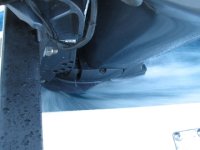Kanaloa:
From the sounds of things, you are burning about 11 gph to do 20 knots in a Tom Cat 25.5 with Honda 150s. A trifle slow perhaps, but pretty close to 'normal'.
Depending on circumstances, that is very similar to what I have obtained with an identical Tom Cat over the past 5 years, and several hundred hours of operation in a carefully maintained, bottom painted boat. So, you may not have anything really "wrong" at all.
But, perhaps your boat is just a knot or two slow. Before spending any money, you might try the following:
Are your speed readings coming off the GPS or a water speed sensor? I have found the latter to be somewhat unreliable. Check your GPS speed in one directly, then turn 180 degrees and run the other. Average the speeds, and compare that to your water speed sensor. Trust the GPS numbers.
The most efficient engine trim position in my boat is about a 2 on the Honda engine trim gauge which has 5 positions, the latter being engine highest. The correct trim position varies slightly with weight, and is worth 1 - 2 knots. So get your GPS going and try different trim positions at different power settings, and log the results. Take your time, as a small engine trim change can all of a sudden make a big difference in speed.
Check to see where your engine mounts are set. From the factory, the engines were mounted too high out of the water on my Tom Cat. Lowering them by one bolt hole (about 1.5 inches), made some difference, and also resulted in more reliable cooling water intake. Before doing that, the over heat light would come on from time to time, shutting the effected engine down.
Keep the boat as light as possible. Cats are very weight sensitive, and a Tom Cat 25.5 with full tanks has some 800 lbs of fuel on board, or enough to run for 10 hours. There is no reason most of the time to carry that much fuel, and you will definitely notice the difference at say half tanks. Same goes for the water tank, which holds another 240 lbs. In addition for some reason when we put 'stuff' in the boat, it tends to stay there. With time this can also add a lot of weight, so sort through what you have on board and eliminate what you really don't need.
Pull the hatch covers off the aft engine mount brackets and check to see if they are full of water. The covers have a seal that tends to leak, which can slowly fill the bracket up. The phenomena tends to be worse on the starboard side, because a Tom Cat is slightly heavier on that side to begin with. The engine mount bracket can hold a good 30 gallons on each side. At 8 lbs per gallon, you could be carrying another 500 lbs back there...a bad place to have the weight if attempting to get the boat on a plane.
All of the above could add nearly a ton of weight to your boat, and that you will clearly notice in terms of speed and fuel burn.
As you have suggested, keeping the boat 'bow' heavy does seem to help get it on the plane faster, but am not sure it makes it run faster. In mine, there is 200 feet of anchor chain in the bow locker, plus another 100 feet of line, and it does plane out a bit faster than others I have been in. But not enough (other than for anchor chain reasons), to go to the trouble of adding weight in the bow.
Finally, when new the boats usually came set up with sea level operation in mind. There is a considerable difference in prop requirements between sea level salt water, and higher altitude fresh water. In mine, the sea level props will not plane the boat in fresh water at 3000 feet, regardless of throttle setting. If you are operating in fresh water, well above sea level, you might want to try a smaller prop.
Good luck.
Kevin Ware
El Gato Thomas
Tom Cat 25.5

